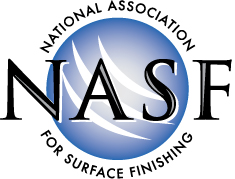|
EPA PFAS Survey Closes: The Surface Finishing Industry Response
The U.S. Environmental Protection Agency (EPA) launched the most recent stage of its PFAS rulemaking process with an extensive industry survey to over 2,000 facilities to inform one of two “first-of-its-kind” PFAS wastewater discharge rules for manufacturing. The survey included an sprawling set of information requests regarding facility operations and processes, use of PFAS, PFAS discharge data, water discharge permits, and financial information.
The NASF launched a series of webinars for members to guide the finishing industry on responding to the U.S. Environmental Protection Agency’s PFAS survey. Accurate responses to the survey that are representative of the industry are critical because the information from the survey will help to shape the rule for PFAS wastewater discharges.
As of mid-March 2024, EPA had received approximately 950 responses to the survey and nearly 650 were from chromium finishing operations. Any company still working on the survey response should submit it to EPA as soon as possible. This high response rate to the survey from the industry will ensure that more accurate information is used in rulemaking deliberations.
EPA will now review the survey results and begin to develop the proposed PFAS wastewater discharge rule. Before issuing a proposed rule, EPA will also have to conduct a small business impact panel to solicit information on the potential economic consequences of the proposed rule on small businesses and to consider options for minimizing that impact. Officials have targeted December 2024 as the date for a proposed rule, but with the delay in sending out the survey and the required analytical steps ahead for the agency, the deadline for the proposed rule may be extended into 2025.
The association will continue to work closely with EPA officials on the development of this critical rule for the surface finishing industry. If members have questions or would like additional information on the survey or the PFAS rulemaking process, please contact Jeff Hannapel or Christian Richter with NASF at jhannapel@thepolicygroup.com or cichter@thepolicygroup.com.
Latest Action on Federal Climate Disclosure Rules for Industry: Securities and Exchange Commission Scales Back Requirements under Pressure
On March 6, 2024, the Securities and Exchange Commission (SEC), responding to pressure from a wide range of industry and agriculture efforts, adopted narrower final rules to require publicly traded companies to disclose “any climate-related risks that have materially impacted or are reasonably likely to have a material impact on the registrant, including on its business strategy, results of operations, or financial conditions.” Specifically, the final rules require disclosure of more direct greenhouse gas (GHG) emissions (referred to as Scope 1 and Scope 2 emissions) on a phased-in basis by certain larger companies when those emissions are material.
In addition, climate-related disclosures must be incorporated into annual reports filed with the SEC. The final rules also include a phased-in compliance period for all companies (extending from FY 2025 to FY 2033), with the compliance date dependent on the company’s filer status and the content of the disclosure,
Changes from Proposed Rules
The final rules include significant changes from the proposed rule regarding GHG emissions disclosure requirements. In addition to the fact that the Scope 1 and Scope 2 disclosures are no longer mandatory for all companies, the amended rules no longer require companies to report certain indirect emissions, including from their supply chains and customers’ use of their products, such as coal or crude oil, or so-called Scope 3 emissions. Companies had opposed the requirement, saying they would be overly burdensome and complex.
Court Stays the Final Rules
Shortly after the SEC ruling, a coalition of 10 states filed a legal challenge, claiming that the rule was “illegal and unconstitutional.” In addition, an industry coalition led by the U.S. Chamber of Commerce also filed a suit seeking to halt implementation of the SEC rules. Other individual companies also filed legal challenges to the final rules.
On March 15, 2024, a U.S. appeals court has temporarily halted new rules issued by the SEC.
In arguing for an administrative stay of the final rules, the companies argued that the climate rules “directly or indirectly regulates significant aspects of the country’s economy under the guise of requiring detailed (and wildly speculative) disclosures about ‘climate-related risks’ and ‘greenhouse gas’ emissions,”
Impact on Surface Finishing Operations
First, the climate disclosure rules apply only to publicly traded companies. Surface finishing operations would have been most directly impacted if customers subject to the rule needed information from them regarding GHG emissions in the supply chain. Given that the SEC removed the reporting of Scope 3 emissions from the final rules, such information will not be federally mandated from surface finishing operations. In addition, it appears that legal challenges to the SEC rules will delay any implementation of the climate disclosure requirements. However, even though there may be no specific regulatory requirements climate disclosure, many large companies may still request climate-related information from its supply chain (including surface finishing operations) as part of their corporate sustainability programs.
Accordingly, NASF will continue to monitor regulatory developments and climate disclosure trends and how it may impact the surface finishing industry. If you have any questions or would like additional information regarding the SEC climate disclosure rules or GHG reporting requests, please contact Jeff Hannapel or Christian Richter with NASF at jhannapel@thepolicygroup.com or crichter@thepolicygroup.com.
Michigan Advancing on PFAS in Wastewater and Stormwater Discharges
NASF recently participated with Michigan industry leaders at MiNASF chapter’s annual technical and industry event in Grand Rapids, and met with officials from Michigan’s Department of Environment, Great Lakes, and Energy (EGLE) to discuss a range of topics, including: EPA’s PFAS wastewater discharge rule, EGLE’s industrial pretreatment program for PFAS, and EGLE’s stormwater program for PFAS. Michigan agency officials noted that its effort to address PFOS in wastewater discharges to POTWs has been successful thus far, and it is now beginning to focus on addressing PFOS in stormwater.
Industrial Pretreatment Program
With regard to the industrial pretreatment program for discharges to POTWs, EGLE reported that it had identified 181 sources of PFOS and 55 of them were metal finishing facilities. Of those 181 sources of PFOS, 87 had installed PFOS pretreatment, and 32 of the 87 were metal finishing facilities. Based on the industrial pretreatment program, POTWs reported reduction of PFOS in its effluent by 84 to 99 percent (with most POTWs having reductions in excess of 95 percent). In December 2019, only 72 percent of POTWs meet the Michigan surface water quality value of 12 ppt for PFOS (including all of the POTWs that did not have any sources of PFOS). As of February 2024, 93 percent of POTWs are now meeting the 12 ppt surface water quality value.
Industrial Stormwater Discharges
With the success of the industrial pretreatment program in significantly reducing the amount of PFOS in effluent discharges, EGLE has also turned its attention to reducing PFOS in industrial stormwater discharges. Approximately two years ago, EGLE started identifying potential sources of PFOS in stormwater and then conducted investigations to characterize stormwater discharges. 45 facilities were investigated and 20 facilities were set for enforcement and corrective action (15 of those 20 facilities were metal finishing facilities). EGLE sent letters to the facilities targeted for corrective action to initiate enforcement through a general administrative consent order (GACO).
After a lengthy period of inactivity on this matter, EGLE is now expected to proceed with implementing corrective action with facilities by Summer 2024 through the use of a GACO. The GACO process would not include any up-front penalties and would allow facilities to identify and implement appropriate site-specific corrective actions.
The corrective action would target source removal instead of requiring the collection and treatment of stormwater. Corrective actions could include the following:
- Clean contaminated surfaces, equipment, tanks and other ancillary pipes,
- Reseal or replace roofs,
- Resurface parking lots,
- Replacement of line contaminated storm sewer pipes and down spouts, replace air handling equipment, and
- Elimination of stormwater exposure to contaminated equipment or materials.
The GACO would also include stormwater effluent goals, and failure to meet these goals would trigger additional corrective actions, but not financial penalties. In addition, the GACO would include ongoing compliance monitoring and performance certification.
While EGLE’s GACO process provides flexibility, facilities will need to work with EGLE to identify and remove the source of PFOS in stormwater. As long as facilities continue to work with EGLE in implementing corrective actions to remove PFOS in stormwater discharges, the agency does not include to impose any penalties.
As NASF continues to work with EPA on the development of the PFAS wastewater discharge rule for the surface finishing industry, EGLE continues to address PFAS in wastewater and stormwater discharges and appears to be setting the standard for the surface finishing industry. If you have any questions, please contact Jeff Hannapel or Christian Richter with NASF at jhannapel@thepolicygroup.com or crichter@thepolicygroup.com.
EPA Racing to Complete Priority Rules Before Possible Congressional Review Act Deadline
EPA top officials have acknowledged that the agency is working to finalize a suite of major environmental regulations by the end of May 2024 to avoid a possible reversal of the regulations pursuant to the Congressional Review Act (CRA) should Republicans gain control of both chambers in the next Congress. The CRA applies to final rules, including major rules, nonmajor rules, interim final rules, and may even include guidance documents and policy memoranda. Typically, the CRA is most often applied to rules that were promulgated in the last six months of a previous Administration.
The CRA enables Congress to disapprove a final rule or policy issued by a federal agency. A rule or policy disapproved using this mechanism is not only nullified; the agency is also prevented from reissuing a “substantially similar” rule or policy in the future unless Congress authorizes it to do so via subsequent legislation.
As a result, EPA is accelerating its efforts to finalize several major air, water, waste, and chemicals management rules and policies in the next two months to avoid the potential risk that priority regulations could be rescinded by a new Congress after the November elections. Vicky Arroyo, head of EPA’s Policy Office indicated that this risk is “something that we’re very focused on,” and that the White House “is working very closely with [EPA] to ty to get our priority rules done as soon as possible because we are obviously . . . just aware of that risk.” NASF will continue to engage closely with EPA on its near-term regulatory agenda and provide updates to NASF members. If you have any questions or would like additional information regarding this issue, please contact Jeff Hannapel or Christian Richter with NASF at jhannapel@thepolicygroup.com or crichter@thepolicygroup.com.
NASF 1000
The NASF 1000 program was established to ensure that the surface finishing industry would have resources to effectively address regulatory, legislative and legal actions impacting the industry, NASF members and their workplaces. All funds from the NASF 1000 program are used exclusively to support specific projects and initiatives that fall outside the association’s day-to-day public policy activities. The commitment to this program is one of the most vital contributions made in support of surface finishing and directly shapes the future of the industry.
The sustained commitment from industry leaders has helped the NASF remain strong and credible in informing regulatory decisions across the nation. Specific projects funded through the NASF 1000 make a measurable difference in how the industry navigates emerging challenges, communicates credibly with policy makers, and advocates for a strong science base for rules or standards that affect surface finishing.
Please consider supporting the NASF 1000 program. If you have any questions or would like additional information regarding the NASF 1000 program or the broad array of NASF public policy activities, please contact Jeff Hannapel with NASF at jhannapel@thepolicygroup.com.
|


